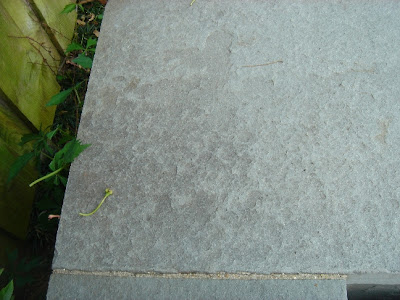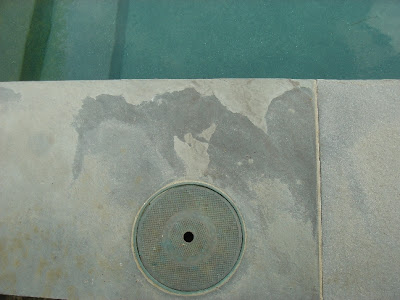

X50 Magnification
This is your Polaris 280 Drive Shaft On Salt


X50 magnification
I pulled this out of one of my pools last week:
I’ve serviced this pool since it was new. It’s a pristine clean, 20,000 gallon, dark blue plaster pool with Oklahoma flagstone coping and rock hardscape - spa waterfall and diving rock. It has a Zodiac Clearwater LM2-24 salt system. It filled July of 2003. The Polaris is almost four years old. It runs 3 hours a day. I know because I set the program times and I preach to my customers that 3 hours a day is all that a Polaris needs to clean their pool. If you run it 4 hours a day, that’s a 33% increase in run time and you’re just going to wear it out that much faster. So, 3 hours a day is ideal.
I say three hours a day because a Certain Sales Rep told me so - back when he was wearing a Polaris hat - and in those days, that was all I needed to know. And the truth is, I still prefer, recommend and sell Polaris 280's. For two reasons; It’s the Best Cleaner on the Market, and that Certain Sales Rep was, and is, the Best Salesman on Planet Earth, and I’d still stop and listen to his spiel even today, no matter what he was selling. I even forgive him for selling me Jacuzzi Earthworks filters Back In the Day. And I forgive him because I truly believe he believed Jacuzzi when they told him that he was selling a better, more economical filter, with a flat plane grid pack less apt to bridge and a filter that was overall easier to service than the competition. It didn’t work out that way, but that’s a whole other blog.
And Back In the Day you could go to a guy like him and tell him what you were seeing - like a Polaris 280 drive shaft being eaten alive by salt. And The Word would go up the line and his company would talk to that salt company and who know’s what really got resolved. When it got to that level, a one-pole Pool Guy and even the Regional Sales Rep were pretty small potatoes and hardly in the loop in those discussions.
But at least you had a sense that we were all working toward that common goal of making our industry one small step better.
But the waters are so muddy now. It’s hard to know what to do. You see, the company that makes the salt system that ate up that drive shaft, Zodiac Pool Care, bought Polaris Pool Systems on January 18th, 2005. So, you don’t hear a lot about Polaris ranting and raving that these salt systems are eating up their cleaners any more. And maybe they never did. Maybe I was a fool to believe that Polaris looked at a situation as a problem that needed resolution, instead of an opportunity to Sell More Drive Shafts. I don’t know.
But I do know this. I pulled this Polaris 280 out of a pool 02/11/06.
It came out of a 30,000 gallon pebble finish pool with Oklahoma flagstone coping and decks and waterfall. This pool was brand new and fresh filled on 02/16/04. This pool also has a Zodiac Clearwater LM2-40 salt system. I had to replace the wheel bearings and the wheels when I replaced that drive shaft. At the time, this wasn’t happening to my other two year old Polaris cleaners, so I figured it was a combination of the bumpiness of the pebble finish, in conjunction with the salt, that caused that Stainless Steel Drive Shaft to last about as long as the plastic teeth on the wheel it was meshing with. And I think I was right. Because the drive shaft at the top of this page lasted twice as long on a smooth plaster surface.
Here’s what the bearings and wheel on this week's Polaris look like:
That rusty, dissolving drive shaft pretty much chattered those bearings apart. Left a nice stain on that black plastic, too.
Here’s one more picture.
This is a side by side comparison of the new and old drive shafts. You can see how the rust on the old one has stained the white plastic with a brown patina. It’s much like the staining that I’ve documented in the two previous posts. And always, it’s related to the deterioration of metal parts that weren’t supposed to deteriorate in that way. I mean, Stainless Steel sort of implies, well, Stainless. Get it? But as any sailor or marine electrician knows, there’s no such thing as a Stainless Steel that won’t eventually corrode in the presence of salt. There’s a neat web page that shows exactly why. Here’s the link:
http://infohost.nmt.edu/~burleigh/
And here’s an image I borrowed from that page that points out the importance of chloride (Cl-) in this process. You know, chloride. As in sodium chloride-the-stuff-you’re-pouring-in-your-salt-pool-like-there’s-no-tomorrow chloride. That chloride. The one whose level you’ve jacked by a factor of at least seven - for an older pool that hasn’t been drained and refilled in a long time - and as much 65 times normal - if your pool’s a fresh fill and your tap water is around the 60 ppm that the EPA would like to see it at.

This webpage is hosted by T. David Burleigh, PhD & PE, Physical Metallurgist, Corrosion Specialist, and Instructor, an Associate Professor at the Materials and Metallurgical Engineering Department , New Mexico Tech, Socorro, NM 87801, and I really appreciate that he’s hosted it for those of us who don’t have time to move to New Mexico and attend his classes. Although I am going to look into buying one of his books at Amazon.
So, now we kinda see the mechanism for how the drive shaft went south on us and turned to rust. At least that’s one scenario. But I think there’s something else going on here as well. Our old friend Galvanic Corrosion. Here’s why:


These are pictures of the Locking Pin that holds the drive shaft turbine in place on the drive shaft. How much you want to bet that they're dissimilar metals? How much you want to bet that they’re just slightly different grades of Stainless Steel? And that slight difference set up a Galvanic Cell that traveled out to the tip of those shaft teeth and set them to corroding, and staining.
And why do I think it was Galvanic Corrosion? Because the new Polaris 280 drive shafts don’t have a Locking Pin to hold it onto the shaft. Next time you buy one, look for yourself. You’ll see. And if you have any salt pools that you take care of, believe me, you’ll be buying one soon.
So, what’s my point? This:
Polaris will sell more drive shafts as a result of the addition of salt to the pool water. And the consumer will pay for that. They’ll pay for the new part - about $30 - and perhaps the labor to put it in, because Polaris has changed their warranty, just like everybody else since salt came along, to one year on internal parts. It used to be 2 years, if you bought the booster pump and cleaner at the same time. But that’s about how long those drive shafts last in a pebble surface pool. And while that wouldn't have helped the four year old pool that I pulled the cleaner out of this week, they're still selling a drive sahft earlier than they would have anyway.
My other point is really a supposition, if Zodiac had never bought Polaris, would Polaris have eventually gone toe to toe with them and all the other salt system manufacturers over failed parts caused by salt water? We’ll never know. And we’ll never know if the change to that drive shaft is due to Galvanic Corrosion. Because you can bet your bottom dollar that even if it is - and the photographic evidence indicates that it is - and even if the engineers back at Polaris have a definitive report stating such, that report was long ago buried deep in the Zodiac Pool Care corporate archives, stamped "Proprietary Information. Do Not Release".
Zodiac bought Jandy this year. It was shortly after Jandy had purchased Chlormatic and renamed it the Aqua Pure.
Hayward bought Goldline Controls in September, 2004. When did they start offering cupro nickel heat exchangers on their H series heaters? To quote from their own website that you can go and check out Right Now; "Hayward H-Series heaters are all equipped with a Cupro Nickel Heat Exchanger for efficient heating and superior durability. Cupro Nickel provides improved durability and longevity against the damaging effects of erosion that can occur under high-flow conditions, corrosion from occasional pool chemical imbalances, and is ideal for salt-water based pool systems."
Here’s the link:
http://www.haywardnet.com/inground/products/heaters/H-Series.cfm
Right there, they’re equating "salt-water based pool systems" with "erosion that can occur under high flow conditions" - APSP calls that impingement corrosion and we’ll be talking more and more about that since I finally got a microscope and a way to start observing it - and "corrosion from occasional chemical imbalances". By implication then, the old copper heat exchangers won’t stand up to, "the damaging effects of erosion that can occur under high-flow conditions, corrosion from occasional pool chemical imbalances, and... salt-water based pool systems".
You can go one of two ways here. You can dismiss me as a Crackpot of the Highest Order, or you can Step Through The Looking Glass with me and look at this photo:

This is your Heater Heat Exchanger on Salt.
So, the next time you get a chance, ask your Polaris Rep whatever happened to that Locking Pin on the old 280 Drive Shaft? You see, if you know the answer to the question before you ask, then you can see for yourself that they’re BS’ing you. Then you can start applying that Unfortunate Fact of Life to everything else they tell you. Because the truth is usually "Proprietary Information: Do Not Release". And they have to tell you something or you’d stop buying their stuff.
You see, they’re not really lying to you. They’re protecting Company Sensitive Information.
And still, you may ask, what’s my point? This:
There’s nobody left out there that’s big enough to take on what used to be little old salt system manufacturers. They’re all huge multinationals now. They own the salt systems, or the salt systems own them, and instead of complaining that salt is ruining their products, they’re sending an internal document from one department to the other, making subtle equipment changes and passing the cost onto you and your customer.
If that’s okay with you, then So Be It. But then, stop telling me salt’s cheaper to use. Because everywhere I look, I see added cost after added cost, and nobody’s talking about it.
By the way, have you noticed that little holes are showing up on the old style Polairs wall port finger screens on salt pools? It looks like the mesh is just dissolving away. Gee. I wonder what's causing that?
And last but not least; I mentioned that both of these pools had Oklahoma flagstone, and they're both two of the dustiest pools on my route as that salt splash out continues to erode that softer Oklahoma flagstone.

























